Stereo amplifiers are the most common type of amplifier in hi-fi systems. They’re designed to process and amplify a stereo signal, and then drive a pair of speakers. While the basic concept of stereo amps hasn’t changed much over the years, hi-fi remains a legacy-driven hobby – one that often balances a respect for the past with a desire to innovate.
Modern stereo amps tend to include a range of quality-of-life improvements, such as Bluetooth and built-in Wi-Fi modules, allowing you to stream digital music without needing additional components. Some models also feature HDMI connections, making it easier to integrate them into a 2-channel home cinema setup.
Given how complex the world of stereo amps can be, I’ve compiled the best stereo amplifiers on the market today to help you find the right one for your setup.
In a hurry?
If you want the best of the best, here are our top three picks:
| Naim Uniti Atom | A compact all-in-one amp with streaming, HDMI ARC, and a rich, musical sound. Feels properly premium and sounds fantastic - my personal favourite and a joy to live with. | Check the current price |
| Marantz PM6007 | A classic no-fuss stereo amp with a warm, forgiving sound. Perfect for those after a traditional setup without breaking the bank. | Check the current price |
| Technics SU-R1000 | High-end, powerful, and ultra-refined. Delivers clean, dynamic sound with stunning control. It’s serious hi-fi kit. | Check the current price |
Why we’ve chosen these amps
I’ve based my selection partly on personal opinion, shaped by my own listening experience and years working in hi-fi sales. These are amps I’ve actually used, demoed, recommended to customers, or simply had a proper play with over the years. There are also a few customer favourites that we’ve seen remain ever-popular over the years.
The list includes some well-known classics and one or two that genuinely surprised me. I’ve made a point of not just listing the most expensive or heavily specced amps – because more features don’t always lead to a better experience. Sometimes, simplicity just works.
This isn’t a technical checklist. It’s not a list based solely on power output or spec sheets. It’s a collection of amps that, in my view, get something right – whether that’s sound, feel, functionality, or just the way they make you want to keep listening. These are amps I can genuinely stand by and say – yes, that’s a great bit of kit.
The best stereo amplifiers
1. Naim Uniti Atom – Premium compact system for modern streaming and hi-fi purists
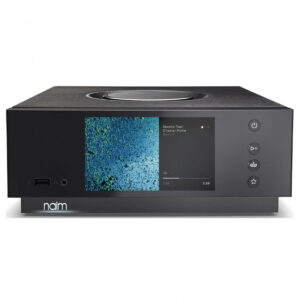 Key features
Key features
- Network streaming functions
- HDMI connection for AV integration
- 40W Class A/B amplification
Pros
- Sounds excellent – rich, warm and musical
- Multifunctional, with an HDMI connection
- Full-function app support
Cons
-
No phono stage
I’m going to start with a bit of bias and get it out of the way – and I’m also going to roll two more amps into this section, as they’re essentially elaborations on the same core unit.
When I was building my setup, I spent the better part of a year agonising over which amp to choose. I knew I wanted something with streaming capabilities, as that’s my primary media source. I also wanted HDMI connectivity so I could use it as a two-channel home cinema amp, and I needed it to be compact. The Naim Uniti Atom ticks all those boxes.
I’d go as far as saying the Uniti Atom is the best thing I have ever spent money on, full stop. It sounds fantastic – whether you’re streaming lossless audio, spinning a record, or watching a film, the Atom handles it all with ease.
But it’s not just the sound – it’s the whole experience. The volume dial feels solid and satisfying, the display is crisp, and the app is actually smooth and responsive. It feels like a product that’s been properly thought through from top to bottom.
There’s no illusion that it’s a premium amplifier. Powered by Naim’s decades of expertise, the Atom features a 40W Class A/B amp – plenty for most speakers, but it really shines with higher-sensitivity models like Focal’s Aria range. You’ve also got RCA in, pre-out, and optical inputs for flexibility.
Now this is where the other two amps come in – the Naim Uniti Star and Nova. The Star and the Nova are much larger physical units, by about 20cm. However, the Star features a CD ripper akin to the Uniti Core and increases the output power to 70W, allowing it to have even greater dynamic range and extra functionality, whereas the Nova eeks out another 10W of power, bringing it up to 80W of Class A/B goodness.
2. Marantz PM6007 – Beginner-friendly workhorse with a warm, classic sound
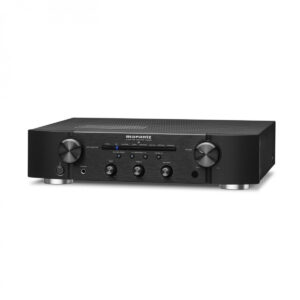 Key features
Key features
- Bass and treble controls
- Built-in phono-stage
- 45W Class A/B amplification
Pros
- Classic, timeless styling
- Fantastic value for money
- Very warm and forgiving sound
Cons
-
The EQ isn’t the best
The PM6007 would be my “default amp option” in that if you were to ask me to imagine an amp, a PM6007 or something that looks identical comes to mind. Drawing the comparison to the Naim units in the section above, the PM6007 is a wildly different type of product. It doesn’t have any built-in streaming modules, nor a big fancy screen or HDMI inputs. But it is still Class A/B and delivers 45 watts per channel.
The sound out of the PM6007 – although on paper the numbers are the same as the Atom – doesn’t have quite the same refinement, which you’d expect given the price difference. But that being said, the PM6007 is excellent. It has warmth and control and what I would describe as the typically “sweet” sound you’d expect from a Marantz amp.
It comes with the full range of connections given it’s a full-size amp – four pairs of RCA connections and a dedicated phono input with a pretty decent phono stage built in as well. A cool point about the PM6007 is that the phono inputs are labelled and have corresponding labels on the front of the amp, which is a great quality-of-life facet.
You don’t have to use the connections for what they’re labelled for, but it’s a nice touch – and you can always make your own little cheat sheet of what connection is for what use.
The PM6007 is an absolute workhorse of an amp and gets a solid 10/10 from me.
3. Arcam A15 Integrated Amplifier – For those wanting power, control, and the “Arcam” sound.
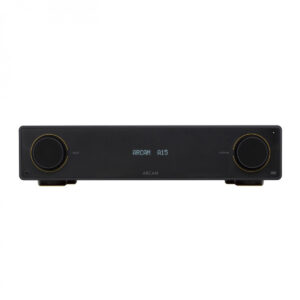 Key features
Key features
- Wireless and wired headphone connectivity
- Hi-res ESS ES9018 DAC
- 80W Class A/B amplification
Pros
- Powerful and dynamic
- Unique styling, with a semi-hidden display
- High-quality ESS DAC for use with digital source
Cons
- Doesn’t feel the most premium
All of the Radia amps – especially the A15 – are excellent. The A15 is a Class A/B amp and has a mighty 80W; it’s very expressive as a result.
It does have that classic Arcam sound: very muscular and clean-sounding – almost a little too clean at times, especially if paired with brighter and more clinical speakers, and much like the SA range of yesteryear, there are the A5 and A25 models should you want less or more power.
The downsides of the amp, compared to the older SA range, are mostly to do with feel.
It’s not nearly as tactile to interact with – the volume knob offers very little resistance, and the stark metal chassis has been swapped for a matte black finish which, while lighter and more rigid than before, doesn’t feel as premium. One of the biggest disappointments is the power button, which no longer delivers that satisfying mechanical clunk.
That said, most of these are minor gripes; they’re completely overshadowed by just how good the A15 sounds. It’s a genuinely expressive amplifier, with great grip and dynamic punch – especially when paired with a balanced, neutral speaker.
It still has that unmistakable Arcam signature: muscular, detailed power. And while I do miss the tactile charm of the older SA series, the A15 is far from a downgrade. It’s more streamlined and lighter and includes everything you’d want from a modern integrated amp, including a very capable built-in DAC and a solid range of digital inputs.
The lack of HDMI is a bit of a shame, but the inclusion of optical does help round out its flexibility.
4. Audiolab 9000A – A clean, versatile amp for flexible hi-fi system building
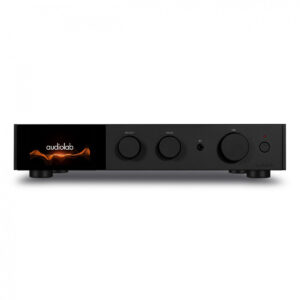 Key features
Key features
- Flexible pre/power amp modes
- ES9038PRO 32-bit 8-channel DAC chip
- 100W Class A/B amplification per channel
Pros
- Big, dynamic sound with excellent control
- Large dynamic display
- Bold, monolithic styling
Cons
- Displayed waveform is generic, not track-specific
From a performance perspective, the 9000A is wonderful. It has power, control, and dynamics. You might find that it’s a little flat sounding… but in a good way – the “flatness” of the amp really allows the source input to shine and do a lot of the overall tone shaping over a relatively clean power platform, and its performance has reminded me in the past of mono-block type setups.
Another major win for the 9000A is its ability to function in pre/power mode. What does that mean in practice? It means you can disable the preamp stage entirely, allowing your source component to handle tone shaping and volume control.
In this setup, the 9000A acts purely as a stereo power amp – making it a flexible component within a system. It can start life as a standalone integrated amp and later be repurposed as a power amp when expanding into a full pre/power setup.
It also boasts a wide range of connectivity options – XLR, RCA, coaxial, optical, and USB. Combine that with 100W of Class A/B power per channel, and the 9000A becomes a seriously capable amp.
That said, the screen does bug me a bit. The fact that the screen displays a waveform of music during playback is a nice touch. However, the waveform is nowhere near what it should be displaying, rather it loops a generic waveform gif. The VU metre options are also pretty cool, although there is about a half-second delay between the audio and the visual which I find detracts from the amp.
The screen feels like a missed opportunity. But to be fair, I might be expecting too much from what is ultimately more of a fun feature than a core part of the amp’s functionality.
5. Marantz M-CR612 – A compact, do-it-all mini system that delivers beyond its size
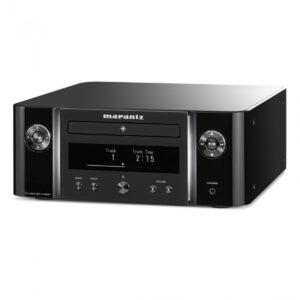 Key features
Key features
- All-in-one network streaming amplifier
- Built-in CD player
- Multi-room functionality through HEOS app
Pros
- Built-in streaming via the HEOS app
- Compact design with a great user interface
- Integrated radio tuner
Cons
- The plastic chassis doesn’t feel premium
The Marantz M-CR612 is one I have recommended wholeheartedly for years. It’s what I would consider the best value-for-money streaming amplifier. The M-CR612 makes use of Denon’s HEOS streaming platform, which doesn’t have any pitfalls in terms of streaming bandwidth, having the capacity for full 192kHz at 24-bit. So if you want to stream FLAC files from your own NAS drive or elsewhere, you’ll be able to.
The amp section is equally impressive, handling high-resolution files with ease. It delivers a smooth, warm tone that stays true to the signature Marantz sound. Despite using 60W of Class D power, it avoids the clinical edge that Class D designs can sometimes have. I hold the M-CR612 in very high regard.
The chassis might not feel great, with a plastic construction that gives off a classic hollow “clack” when you tap it with a fingernail. However, much like my mother used to say, it’s what’s on the inside that counts – and in this case, that rings true.
Look beyond the early-2000s-style plastic exterior, and the internals of the amp are seriously impressive. The performance and value this little amp delivers easily outweigh any complaints about its finish – even if plastic-y-ness isn’t technically a word.
6. Arcam Radia SA35 Streaming Amplifier – A muscular streaming amp built for serious systems
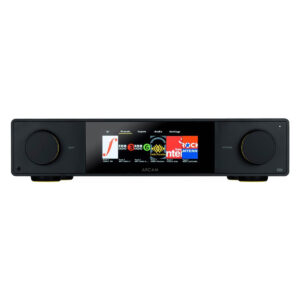 Key features
Key features
- Supports Wi-Fi, Bluetooth 5.2, Spotify Connect, Tidal Connect, and Roon Ready
- Hyperstream iV DAC topology
- 120W of Class G power per channel
Pros
- Clean, powerful and dynamic sound
- Excellent display and user interface
- Class G design balances power and efficiency
Cons
- Lacks a bit of character, subjectively
I managed to have a play with the Arcam Radia SA35 before its official release – and I was thoroughly impressed. The sound from this amp is excellent. It delivers power, muscle, clarity, and width – everything you want to hear from a modern integrated amplifier. And it’s clear which market Arcam is targeting here: this is designed to go head-to-head with the likes of the Naim Uniti series and Cambridge Audio’s EVO range.
To put it simply, the SA35 outputs 120W – three times that of the Atom – and that extra power translates into greater dynamic control and presence. It uses a Class G amplifier, which contributes to its strong, muscular performance while also sounding clean and efficient. Add to that Dirac Live room correction, and you’ve got an amp that can be finely tuned to suit your specific space.
The SA35 is fantastic – it has so much power and control that it will drive your speakers effortlessly, with clarity and transparency.
That said, for all its strengths, it does lack a little in terms of unique personality – at least to my ears. The Arcam sound has never been one that’s made me say, “Yes please, I need that in my life.” It’s more often made me think, “Yes, that’s very cool.” Now, plenty of people will feel differently – and that’s perfectly valid. I can still recognise that this is a seriously capable amp, and it absolutely deserves recognition.
7. Mission 778x Integrated Amplifier – The small amp that doesn’t know it’s small
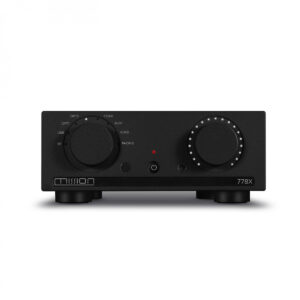 Key features
Key features
- ESS ES9018K2M Reference DAC chip
- Dedicated MM Phono input
- Styling queues taken from the 1983 original 778
Pros
- Compact without compromising on performance
- Tactile rotary knobs and clean interface
- Solid internal DAC for digital sources
Cons
- Lacks HDMI input
The Mission 778x is another compact powerhouse of an amplifier. It has a Bluetooth connection for quick and easy streaming options as well as the usual myriad of analogue connections – RCA, optical, coax, dedicated phono-in and the lesser-spotted USB-B connection.
The 778x is another amp I’ve tried and instantly became rather fond of. I like technology – and products in general – that don’t pretend to be more than they are, and the 778x fits that mould perfectly. In my mind, it falls into the same category as the PM6007 mentioned earlier. It’s simple, but it does simple very well.
What really took me by surprise was the form factor – it’s small. The only amps I can think of that are similar in size are the ones from Cyrus. But don’t be fooled by its size; this is no shrinking violet. With 45W per channel, it has more than enough muscle to drive a wide range of speakers with confidence.
Yes, it does lose out to models like the M-CR612 and the Naim Atom – but that’s to be expected. The M-CR612 offers built-in streaming and app support, making it more flexible, while the Atom is a true Class A/B amp with higher-end components that contribute to a more expansive soundstage.
However, that being said, the fact the 778x is in the conversation with these two other amps should really help shine a light on just how good it is – because it is awesome.
I tested this with a pair of DALI Oberon 5s and was pleasantly impressed at how the amp’s tonality complemented the warmer, softer sound of the DALI speakers, resulting in something that was detailed without becoming shrill or harsh in any capacity.
8. Quad Artera Solus Play/Quad Artera Solus – Monolithic all-in-one, with serious sonic authority
 Key features
Key features
- Built-in CD player
- ES9018 Sabre32 Reference DAC chip handling up to 32-bit/384kHz & DSD64/128/256
- Large selection of connectivity options, including XLR
Pros
- Premium build quality throughout
- Powerful, bold sound with great control
- CD player and streaming built-in, plus wide connectivity
Cons
- Play-Fi isn’t the best streaming platform
So I have an interesting relationship with the Quad Artera Solus Play in that the amplifier is excellent – arguably one of my favourites. As if it’s not clear by now, I like compact amps. This one has power, dynamics, and control, and it just sounds powerful – reminiscent of things like the Roksan Blak.
The built-in CD player is a very nice touch. You can tell, should you ever use the CD function, that it is well-tuned for the amplifier’s character. To that effect, you can tell when listening to it that the amplifier is designed to sound bold without being brash.
Where the Artera falls down, in my opinion, is the use of Play-Fi as a platform for its streaming functionality. Now I know the app has improved drastically over the years, however when I regularly used the Artera, I would avoid the app control altogether, as it would crash the app regularly, functions would freeze, and it was just not a good user experience.
I would much rather rely on things like Spotify Connect to see me through using it.
That said, it feels a bit unfair to judge the Artera purely on its app integration – because at its core, it’s a phenomenal amplifier. The sound is bold, controlled, and effortlessly dynamic. And if you approach it like a more traditional hi-fi amp, using the remote, it absolutely delivers. The small touchscreen isn’t its strongest feature, sure, but once everything’s in place, you’re not relying on it day-to-day.
Treat the streaming as a bonus rather than the main event, and what you’re left with is a seriously well-built, high-performing all-in-one that holds its own in a very competitive space.
Plus, Quad also make a non-streaming version in the form of the regular Solus.
9. Musical Fidelity M5SI – Power, control, excellence
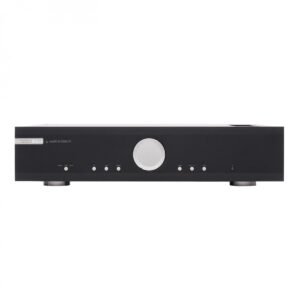 Key features
Key features
- >70dB signal-to-noise ratio with low distortion
- Monoblock power-amp architecture, with a separate pre-amp section
- 150W Class A/B power
Pros
- Clear, warm, and natural sound
- Tough, reliable build – built to last
- Honest, no-frills design
Cons
- Buttons feel a bit cheap and loose
I do feel slightly guilty placing the Musical Fidelity M5SI further down the list because while it’s simple, it’s also exceptionally effective. It doesn’t try to do too much – it just focuses on being a truly excellent stereo amplifier.
With 150W per channel on tap, it delivers power with grace. It’s mighty, eloquent, and – dare I say – kind-sounding. Having spent time with a lot of Musical Fidelity’s gear, I think the M5SI might be my favourite. It just does everything right.
When I tested it, I paired it with the then-new Focal Aria EVO X speakers – specifically the floorstanding No.3 models – and I was genuinely impressed by the result.
At the time, I was heavily into synth-wave and yacht-rock summer vibes, and the amp handled everything from Com Truise to deep Christopher Cross cuts with ease. The combination of those speakers and the M5SI created a sound that was detailed, smooth, and incredibly satisfying.
I was already well acquainted with the sound of the Focal speakers, so I was able to focus more on what the amplifier was contributing to the overall presentation. What stood out was the sense of effortlessness – it had that rare quality you don’t come across often. It actually reminded me of the Roksan Blak (an amp I still mourn, to be honest).
That said, the M5SI also brought an extra clinical edge, which could potentially be a drawback if paired with a brighter speaker. In that scenario, I think the balance could tip too far, undermining some of what makes the amp so appealing. However, pair it with warmer speakers and something like Chord Clearway X, and you have a very well-matched system.
For context, there was a £1000 streamer in that setup, but honestly, anything with a good DAC will create a lush and rewarding listening experience with the M5SI.
10. Denon CEOL RCD-N10 – The best-value entry into mini hi-fi, with streaming and CD built-in
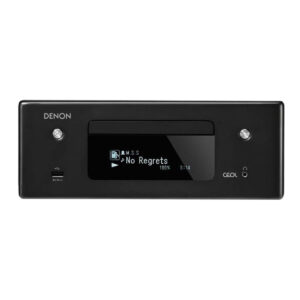 Key features
Key features
- Compact hi-fi amp
- Denon HEOS integration for multi-room and app control
- AirPlay 2 support
Pros
- Compact design with CD and network streaming
- Excellent user interface and HEOS app control
- Smooth, warm sound character
Cons
- Push-clip speaker terminals
The Denon CEOL RCD-N10 is a great little amplifier. It’s essentially the younger sibling of the Marantz M-CR612, and as Denon and Marantz are sister companies, they share a lot of the same R&D and engineering expertise. So the CEOL comes from good stock. It’s a scaled-down version of the M-CR612, and it doesn’t pretend to be anything else.
So, why is it on the list? Well, firstly, the word CEOL (pronounced “Sea-OL”) inevitably earned it the nickname “Kiss from a Rose”. Secondly, it’s an accessible entry point into a broader ecosystem – offering wireless streaming, multi-room connectivity, and a genuinely multi-functional setup, thanks to its built-in CD player and optical inputs.
It slots neatly into any home entertainment system, and it punches well above its weight sonically.
The CEOL sounds great: warm and clear, much like the M-CR612, though it doesn’t have quite the same level of power or dynamic control. It’s much more at home driving bookshelf speakers or smaller standmounts. The M-CR612 can confidently handle larger, more demanding speakers – including floorstanders – but the CEOL is better suited to more efficient designs.
It goes very well with things like the Wharfedale Diamond 9.1, the DALI Spektor range, and the smaller Oberon models.
11. Emotiva BasX TA2 – Excellent installation amp
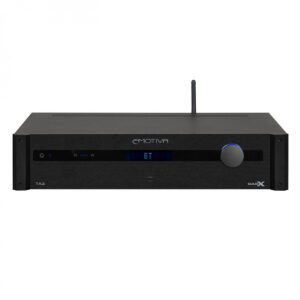 Key features
Key features
- Rackmount compatible
- AD1955 24/192 DAC
- FR4 circuit boards with SMD construction
Pros
- Excellent for custom install setups
- Hi-pass trim pots for fine-tuned sub/pre-out control
- 135W of Class A/B power
Cons
- Basic, utilitarian design
I’ve always been a fan of Emotiva gear – especially for custom installs. Their products are bulletproof, easy to integrate, and they sound seriously good. One project that sticks in my mind involved building a full cinema system around an Emotiva BasX 11-channel power amp and an XMC processor, and once it was all in place, the system absolutely sang.
Later on, when planning a second room, we needed an amp that could hold its own in a rack setup – same footprint, same tonal characteristics – but with a bit more simplicity. Enter the TA2.
It delivered, slotting straight in and keeping that same clean, powerful sound signature. With a generous 135W per channel and plenty of headroom, it had no problem driving demanding speakers – even in larger rooms. And it’s not just “good for the price” – it’s genuinely confident and composed.
It might not win any design awards, but the TA2 isn’t trying to be a lifestyle product. It’s a proper hi-fi workhorse. Whether you’re using it in a comms rack, a living room, or as part of a full-stack system, it’s an amp that puts performance first. Big sound, rock-solid reliability, no drama. Exactly what you want when sound matters more than style.
12. WiiM Amp Streaming Amplifier – The perfect first step into streaming hi-fi on a budget
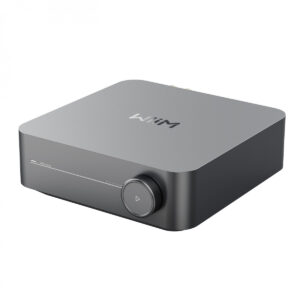 Key features
Key features
- An all-in-one hi-fi solution
- Full app control with 10-band graphic EQ
- 60W Class D power
Pros
- Built-in streaming platform with an intuitive app
- 60W of compact Class D power
- HDMI ARC, optical, and analogue inputs
Cons
- Sound isn’t particularly expressive
When WiiM hit the scene, they made a big commotion – and rightly so. A small, relatively unknown company from China releasing a product that hit a great price point and had lots of great quality-of-life features, was a big deal.
The WiiM Streaming Amp is an impressive little machine. The streaming platform they use is very easy and intuitive, having its own distinct styling and layout as opposed to being a reskin of the usual BluOS platform or a Sonos imitation. It stands out on its own exceptionally well.
The combination of a capable streaming platform and a compact, punchy amplifier would have been enough for most people. But the HDMI ARC and analogue inputs push it even further, turning it into more than just a hi-fi component. It’s a versatile piece of kit that sits comfortably at the intersection of hi-fi, lifestyle audio, and home cinema – all while taking up very little space. That’s something worth applauding.
If I had to pick one downside of the amp, it would be that it doesn’t have a particularly warm or lush tonal character. In fact, it can sound a little stark. That makes speaker pairing – and even cable choice – quite important if you want to get the best from it.
Personally, I would pair this with some warm but direct speakers that are plenty “colourful” – like DALI Oberons, or Q Acoustics 3020is, which with a distinct voice – and then use something honest but not too clean to cable it up (e.g. QED Silver Anniversary), and use the inbuilt graphic EQ to fine-tune things after that.
It’s a cool little amp, no doubt. To find out more, check out our WiiM Amp review.
13. Technics SU-R1000 Reference Class – Reference-grade excellence
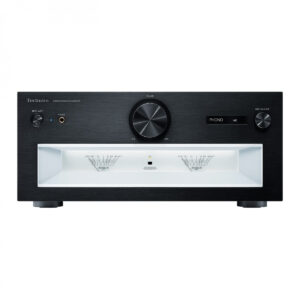 Key features
Key features
- High-grade digital/analogue I/O circuit
- Four individual power supply units for high signal/noise ratio
- 150W Class A/B power per channel
Pros
- JENO engine delivers incredible sonic precision
- Sound is clean, effortless, and detailed
- Premium feel and styling throughout
Cons
- High price point
I love the Technics SU-R1000 – and when I tried it, I asked myself, how did this amp make me feel when I heard it? And the answer is simple – it made me feel fantastic. It genuinely evoked an emotional response (although, to be fair, the blistering volume might’ve played a role).
As a team, we used the amp in the full works of a system – Triangle Lyrr floorstanding speakers, a custom-built DAC full of Black Gate capacitors (if you know, you know), and AudioQuest Rocket 33 cables. We also used an original Technics 1200 from the late ’90s, so we were spoilt. It proved to be a great afternoon.
With that kind of context, the SU-R1000 was playing with gear that matched its calibre – and it delivered one of the most memorable listening sessions I’ve ever had. Borderline religious experience, if I’m honest.
The SU-R1000 gives you power, clarity, effortlessness, and musicality. It was akin to watching Bob Ross paint his happy little trees.
However, though it remains one of the best listening experiences I’ve had, context matters. That entire setup likely cost the equivalent of a small house deposit. And when you’re playing in that league, the curve of diminishing returns becomes very real. That said, if you’re considering dropping approximately £7,000 on an amp, you’re probably not too concerned with that curve.
Jargon buster
Given the nature of the topic, I’ve been throwing around all sorts of jargon and terms that aren’t exactly everyday language – especially if you’re new to hi-fi. Stuff like DACs, pre-amps, Class A/B, impedance… it can all start to feel a bit overwhelming if you’re not sure what it all means. So, to keep things clear and to ensure you’re not left scratching your head, here’s a quick breakdown of some of the key terms below.
| Term | Definition |
|---|---|
| Sensitivity | How loud a speaker gets with a given power input, measured in decibels (dB). Higher-sensitivity speakers need less power to sound loud - ideal for lower-wattage amps like the Atom. |
| Impedance | The electrical resistance of your speakers, measured in ohms. Most hi-fi speakers are 8 ohms. Matching amp and speaker impedance helps ensure clean, efficient performance without distortion or damage. |
| DAC | Digital to Analogue Converter - converts a digital signal to analogue. Read our DAC guide for a deeper insight. |
| Pre-amp | The part of the signal chain that adds character and tone before amplification. |
| Power-amp | The engine that amplifies the signal to a suitable voltage for output to your speakers. |
| Headroom | The extra power an amp can deliver beyond its typical listening level before it distorts. More headroom means your amp can handle sudden peaks (like kick drums or big movie moments) without clipping. |
| Clipping | Clipping happens when an amp runs out of power and can't reproduce the signal properly- basically the audio equivalent of hitting a brick wall. It sounds harsh and distorted and can seriously damage your speakers if pushed too far. |
| Signal-to-noise ratio (SNR) | The ratio between your actual music (signal) and the background hiss (noise). Measured in decibels. Higher SNR = cleaner, clearer sound. Lower SNR = you might notice a bit of hum or fuzz, especially at high volumes. |
Amplifier classes explained
Class D: Highly efficient (80%+). Runs cool, low energy usage. Often found in compact or modern amps.
Class A/B: Less efficient (40–60%) but often sounds better. Warmer, more natural signal response, though generates more heat.
Class G: A hybrid. Dynamically switches power rails to suit demand. Sits between A/B and D in sound and performance. Best of both worlds – though harder and more expensive to design well.
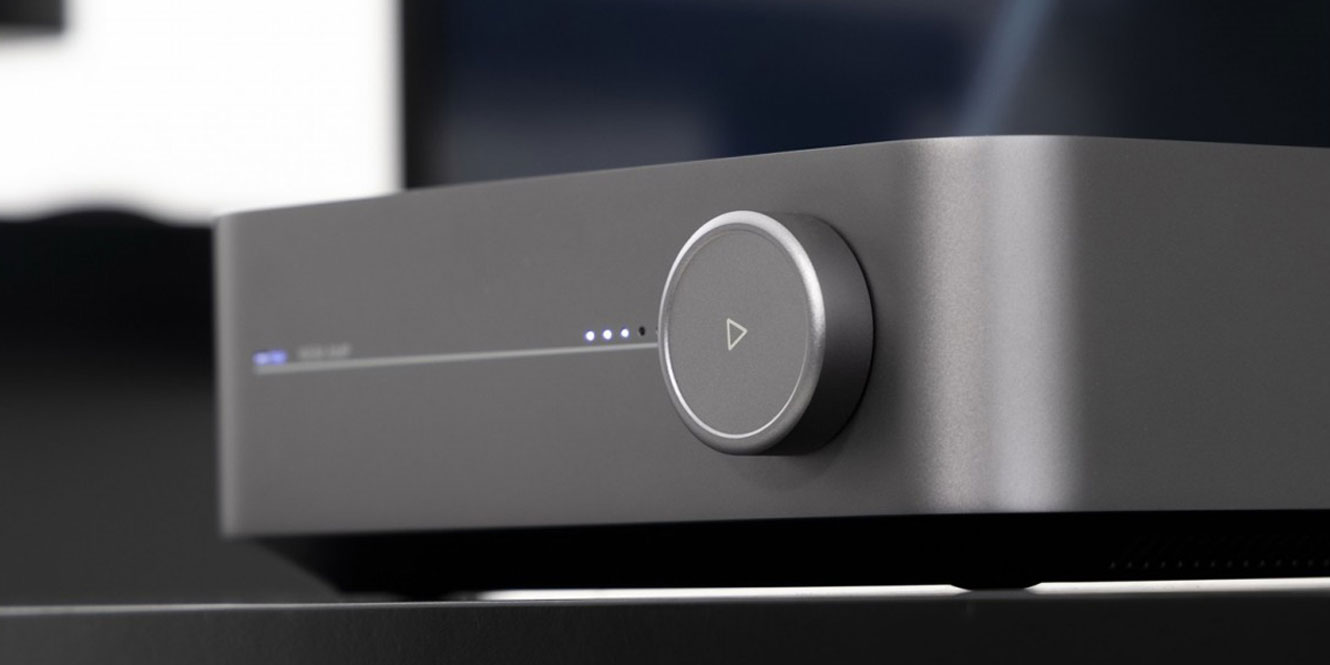
How to choose the best stereo amplifier for you
So, how do you actually pick the right stereo amp? It depends on what you want out of it. What gear do you already have? What do you listen to? How do you want it to feel? The right amp for someone who listens to a lot of ambient or jazz will be very different to someone who’s deep into metal or loves old-school soul.
If you’re into classic rock – stuff like Pink Floyd, Led Zep, or a bit of Dire Straits – you’ll probably want something warm and smooth. Marantz is always a strong shout there. If you prefer fast, punchy electronic stuff – drum and bass, techno, jungle – then amps with tighter control like Arcam, Audiolab, or Musical Fidelity tend to shine.
It’s also worth thinking about features. If you mostly stream music, look at amps with Bluetooth, Wi-Fi, or a built-in platform like HEOS or BluOS. If you already have a DAC or streamer, you don’t need to pay extra for all that built-in functionality. The same goes for phono stages – lots of amps include them now, but if you’re really into vinyl, a separate phono stage might still be the way to go.
The last thing I’ll say is don’t just read the spec sheet. Demo things if you can. Your ears will tell you way more than a list of specifications ever will. And try not to shop with your eyes too much – some of the best-sounding amps aren’t always the best-looking ones. Trust your ears and go with what makes you smile.
If you’re up in the north of England, our staff at our Bacup showroom will be happy to help you test out these amps!
FAQs
How do I choose a good stereo amplifier?
To choose a good stereo amplifier, you first need to find one that matches your speakers in power and impedance. Pay close attention to output wattage, amplifier class (A/B, D, G etc.), and the nominal impedance the power rating is measured at. Most hi-fi speakers are 8-ohm, so use that as your reference point when checking spec sheets and making comparisons.
Do tube amps sound better?
On paper, tube amps sound better but it’s a subjective call and comes down to personal taste. Tube (valve) amps fall under Class A, meaning they’re inefficient but have extremely low distortion and tend to sound warmer and more natural. They work by heating a cathode to emit electrons, which are then received by the anode -creating a physical electrical reaction, unlike a transistor amp which directly alters the signal voltage.
What happens if my amp is too powerful for my speakers?
If your amp is too powerful and you turn the volume up too high, you risk damaging your speakers. A powerful amp can blow speakers if it drives them past their limits. You’ll hear clipping – where the signal peaks exceed what the speaker can handle. Think of it like red-lining a car engine. Too much, too often, and you could tear the drivers or overheat and melt the voice coil – neither of which you want.
Final thoughts
And just like that, we’ve blitzed through a list of what I would genuinely describe as the best stereo amplifiers out there right now. There are others, of course – some more obscure, some more specialised – but the ones I’ve talked about here all have something real to offer. They’re amps I’ve spent time with, messed around with, and in some cases properly fallen for.
But as much as I’ve shared my opinions, don’t just take my word for it. You might listen to one of these amps and not get on with it at all – and that’s fine. If I asked my colleague Robbie for his top picks, I’m sure we’d argue about half the list. It’s not meant to be definitive.
I always say: trust your ears. Don’t let spec sheets, price tags, or brand names do all the talking. If something sounds good to you, then it is good. And if it doesn’t move you – if it doesn’t make you feel something – then what’s the point?
So I’d encourage you to try stuff out. Visit a showroom if you can. If you’re local to Manchester, come and see us in Bacup. If you’re not, there’s always the safety net of a money-back guarantee.
Because at the end of the day, you shouldn’t be buying an amp because it’s the “best”. You should be buying the one that elicits an emotional response. The one that makes you sit back and grin. That’s the best amp for you.
If you’re planning on building your system out, much like this list, I’ve also compiled a list of the best CD players – should you be in the market for CD players. Alternatively, if you’re starting from scratch, or just need a refresher, we have a straightforward guide on how to wire your speakers to your amp.



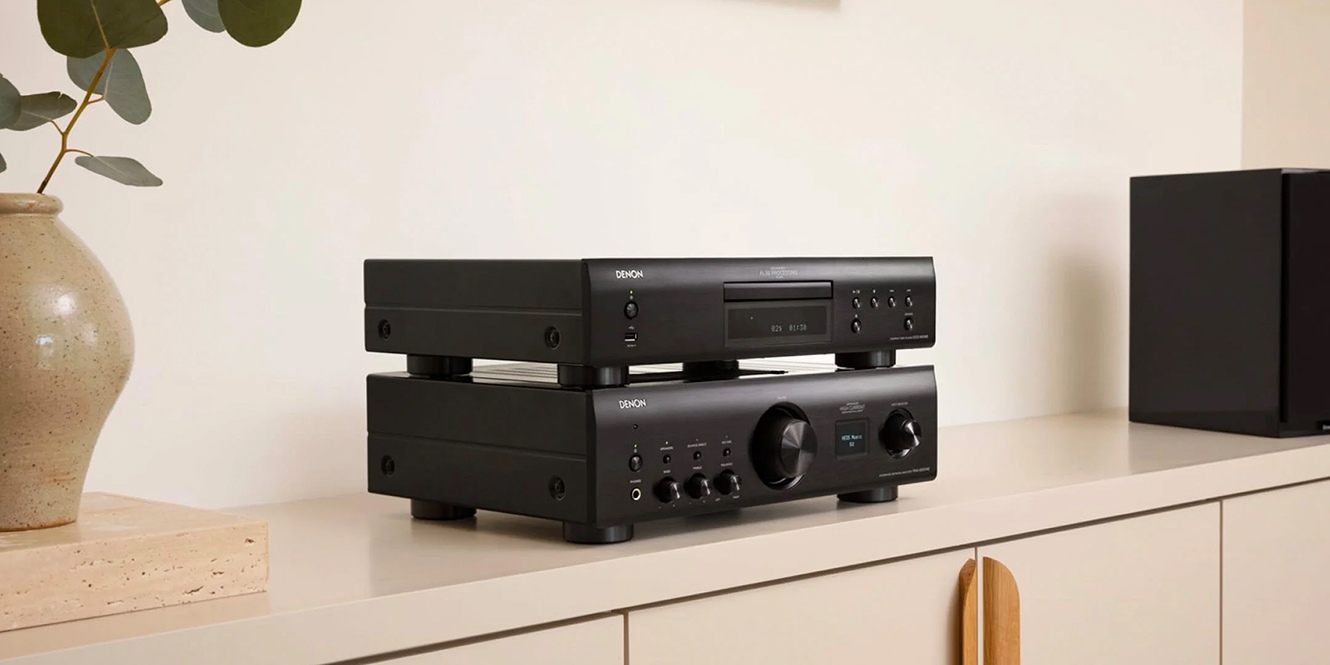
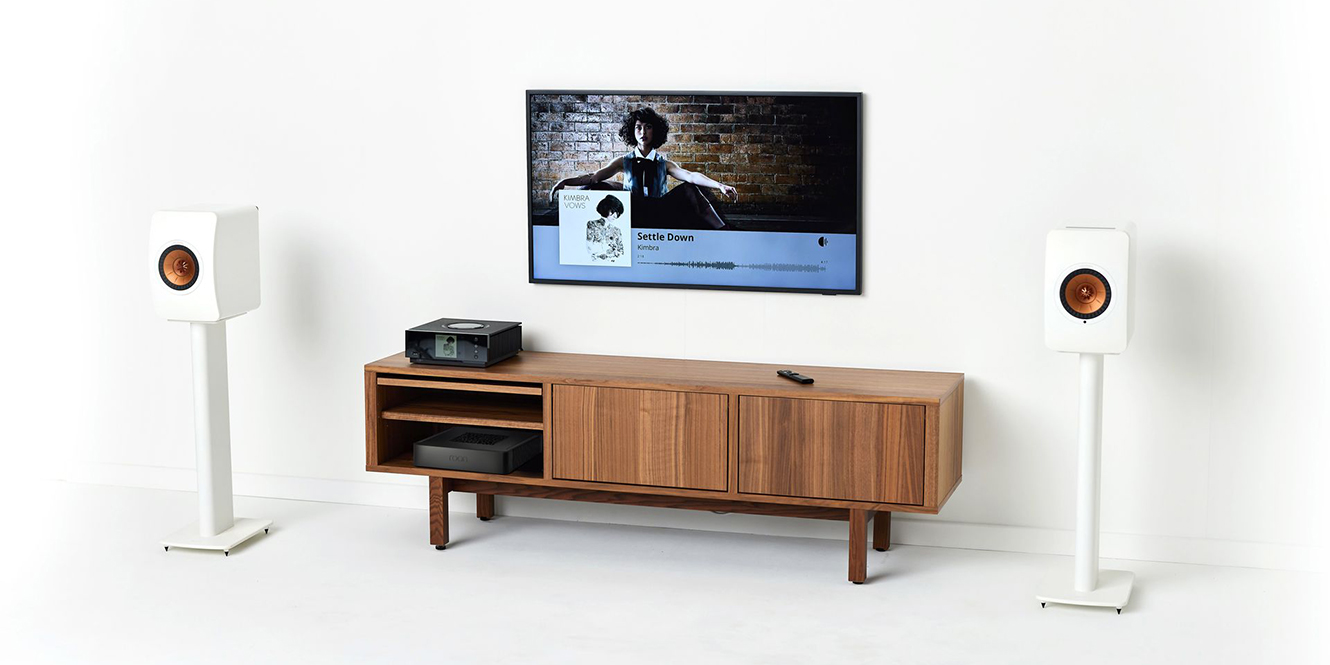

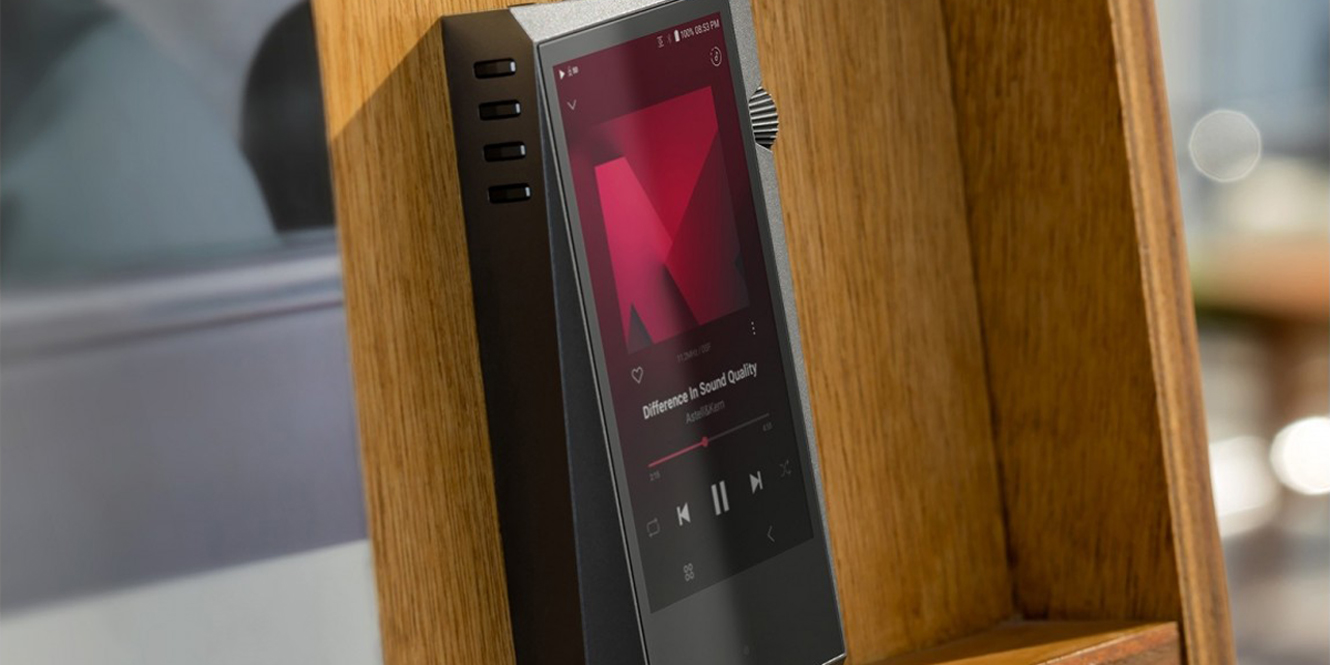




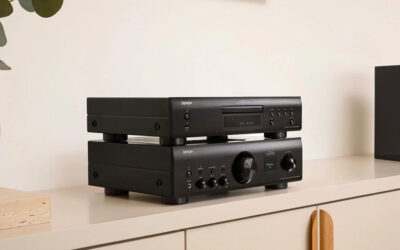
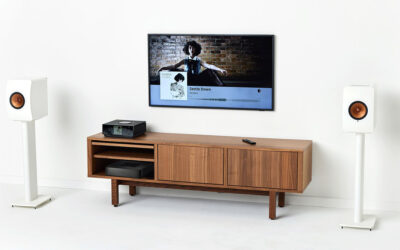
0 Comments